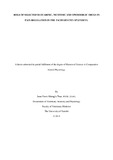| dc.description.abstract | Little is known about nociception in the East African root rat Tachyoryctes splendens. This
therefore prompted further exploration of nociception and antinociception in this species with
specific attention to pain modulation by the cholinergic and opioidergic neurotransmitter
systems. Three nociceptive tests, namely the formalin-, tail flick-, and the acetic acid induced
writhing tests were used to study the nociceptive and antinociceptive effects of selected
cholinergic (oxotremorine-muscarinic receptor agonist and epibatidine-nicotinic receptor
agonist) and opioidergic drugs (morphine-µ-receptor agonist). Oxotremorine (10, 20, and 60
µg/kg dose levels), epibatidine (1, 3 and 10 µg/kg dosage levels) and morphine (1, 3, and 6
mg/kg dosage levels) were administered systemically. Atropine, mecamylamine and naloxone
which are their respective blockers were used for antagonistic reactions. A total of one
hundred and twenty East African root rats were used in the experiments.
In the formalin test, a monophasic (0-5 minutes) pain behavioral response characterized by
biting, licking and favoring of the injected limb was observed. The behavioural response in
the late phase (> 5 Minutes) was insignificantly different (P ≥ 0.05) from that of the controls.
Oxotremorine at the selected doses (30 or 60 µg/kg) induced a statistically significant (P ≤
0.05) dose-dependent reduction in the mean time spent licking/biting the injected paw in the
early phase of the formalin test. The median effective dose was 21 µg/kg. The effect of
oxotremorine (30 µg/kg), on the mean time spent licking/biting the injected paw was reversed
by atropine.
Epibatidine (3 or 10 µg/kg) caused a statistically significant (P ≤ 0.05) reduction in the mean
time spent in licking/biting the injected paw in the formalin test. The median effective dose
was 4.5 µg/kg. Co-administration of mecamylamine with epibatidine (3 µg /kg), significantly
increased the mean time spent in licking/biting the injected paw.
Morphine (3 or 6 mg/kg) caused a statistically significant (P ≤ 0.05) decrease in the mean
licking/biting response. The mean effective dose was 4.5 mg/kg. The effect of morphine (3
mg/kg) was reversed by the administration of naloxone (2.5 mg/kg).
Lower doses of oxotremorine, epibatidine and morphine had no effect on the mean
licking/biting behaviour.
In the tail flick test, with a sensitivity setting of 10, beam at 8 and a cut-off time of 10
seconds, no tail flick was observed even after increasing the cut off period to 20 seconds. The
acetic acid induced writhing test also did not cause any observable nociceptive behavior.
In conclusion, the present data uniquely showed that the formalin test induces a monophasic
pain behavior in the East African root rat and secondly, this species appears to have a
functional nociceptive system sensitive to cholinergic and opioidergic analgesics. | en_US |

